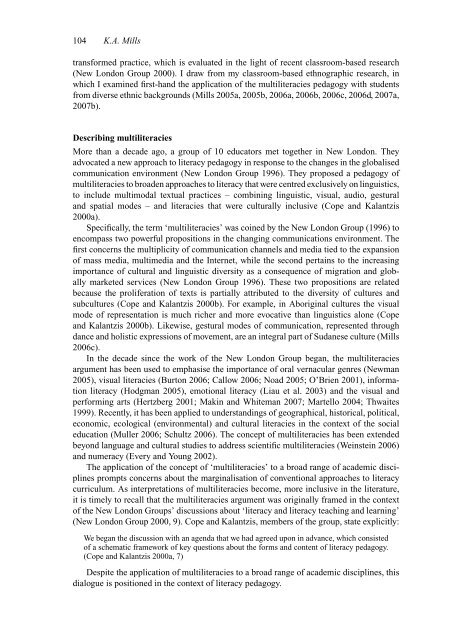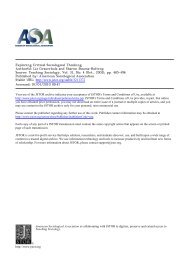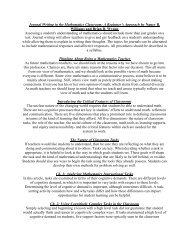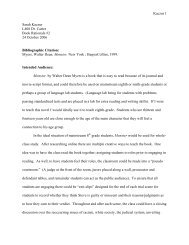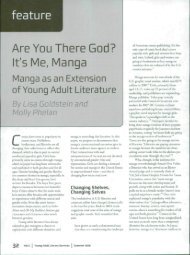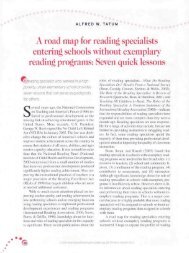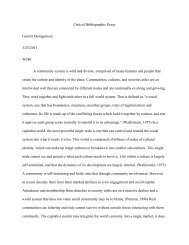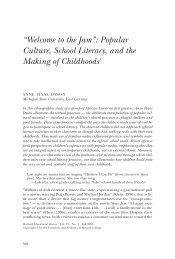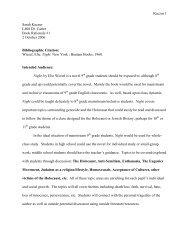Mills (2009) Interogating competing multiliteracy ... - Oncourse
Mills (2009) Interogating competing multiliteracy ... - Oncourse
Mills (2009) Interogating competing multiliteracy ... - Oncourse
Create successful ePaper yourself
Turn your PDF publications into a flip-book with our unique Google optimized e-Paper software.
104 K.A. <strong>Mills</strong><br />
transformed practice, which is evaluated in the light of recent classroom-based research<br />
(New London Group 2000). I draw from my classroom-based ethnographic research, in<br />
which I examined first-hand the application of the multiliteracies pedagogy with students<br />
from diverse ethnic backgrounds (<strong>Mills</strong> 2005a, 2005b, 2006a, 2006b, 2006c, 2006d, 2007a,<br />
2007b).<br />
Describing multiliteracies<br />
More than a decade ago, a group of 10 educators met together in New London. They<br />
advocated a new approach to literacy pedagogy in response to the changes in the globalised<br />
communication environment (New London Group 1996). They proposed a pedagogy of<br />
multiliteracies to broaden approaches to literacy that were centred exclusively on linguistics,<br />
to include multimodal textual practices – combining linguistic, visual, audio, gestural<br />
and spatial modes – and literacies that were culturally inclusive (Cope and Kalantzis<br />
2000a).<br />
Specifically, the term ‘multiliteracies’ was coined by the New London Group (1996) to<br />
encompass two powerful propositions in the changing communications environment. The<br />
first concerns the multiplicity of communication channels and media tied to the expansion<br />
of mass media, multimedia and the Internet, while the second pertains to the increasing<br />
importance of cultural and linguistic diversity as a consequence of migration and globally<br />
marketed services (New London Group 1996). These two propositions are related<br />
because the proliferation of texts is partially attributed to the diversity of cultures and<br />
subcultures (Cope and Kalantzis 2000b). For example, in Aboriginal cultures the visual<br />
mode of representation is much richer and more evocative than linguistics alone (Cope<br />
and Kalantzis 2000b). Likewise, gestural modes of communication, represented through<br />
dance and holistic expressions of movement, are an integral part of Sudanese culture (<strong>Mills</strong><br />
2006c).<br />
In the decade since the work of the New London Group began, the multiliteracies<br />
argument has been used to emphasise the importance of oral vernacular genres (Newman<br />
2005), visual literacies (Burton 2006; Callow 2006; Noad 2005; O’Brien 2001), information<br />
literacy (Hodgman 2005), emotional literacy (Liau et al. 2003) and the visual and<br />
performing arts (Hertzberg 2001; Makin and Whiteman 2007; Martello 2004; Thwaites<br />
1999). Recently, it has been applied to understandings of geographical, historical, political,<br />
economic, ecological (environmental) and cultural literacies in the context of the social<br />
education (Muller 2006; Schultz 2006). The concept of multiliteracies has been extended<br />
beyond language and cultural studies to address scientific multiliteracies (Weinstein 2006)<br />
and numeracy (Every and Young 2002).<br />
The application of the concept of ‘multiliteracies’ to a broad range of academic disciplines<br />
prompts concerns about the marginalisation of conventional approaches to literacy<br />
curriculum. As interpretations of multiliteracies become, more inclusive in the literature,<br />
it is timely to recall that the multiliteracies argument was originally framed in the context<br />
of the New London Groups’ discussions about ‘literacy and literacy teaching and learning’<br />
(New London Group 2000, 9). Cope and Kalantzis, members of the group, state explicitly:<br />
We began the discussion with an agenda that we had agreed upon in advance, which consisted<br />
of a schematic framework of key questions about the forms and content of literacy pedagogy.<br />
(Cope and Kalantzis 2000a, 7)<br />
Despite the application of multiliteracies to a broad range of academic disciplines, this<br />
dialogue is positioned in the context of literacy pedagogy.


